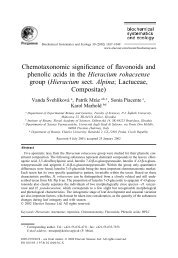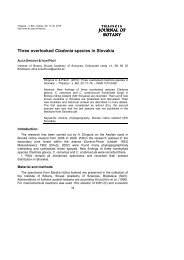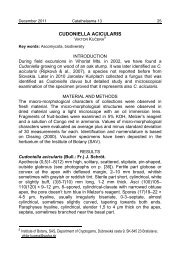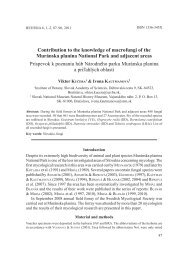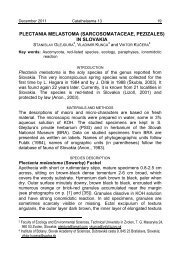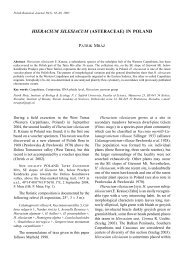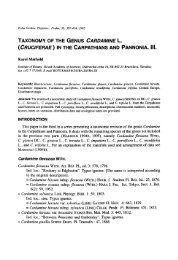Typification of the Linnaean names of the genus - institute of botany ...
Typification of the Linnaean names of the genus - institute of botany ...
Typification of the Linnaean names of the genus - institute of botany ...
Create successful ePaper yourself
Turn your PDF publications into a flip-book with our unique Google optimized e-Paper software.
114 K. MARHOLD<br />
& Suominen, 1994: 155). The morphological differences between diploids and<br />
tetraploids <strong>of</strong> C. amara are ra<strong>the</strong>r minute and <strong>the</strong>re is no way <strong>of</strong> ascertaining ploidy<br />
level from Haller’s description.<br />
Dalibard in Florae parisiensis prodromus (1749) referred to “CARDAMINE foliis<br />
pinnatis, foliolis subrotundo-angulosis” <strong>of</strong> Haller and Linnaeus as well as to<br />
“Cardamine pratensis, flore majore elatior” <strong>of</strong> Tournefort (1719: 224) [correctly<br />
“Cardamine flore majore, elatior”] which was considered by Linnaeus to be a<br />
synonym <strong>of</strong> C. amara, according to his inscription in his own copy <strong>of</strong> Institutiones rei<br />
herbariae (Tournefort, 1719), deposited in <strong>the</strong> Library <strong>of</strong> <strong>the</strong> Linnean Society in<br />
London.<br />
Bauhin in Pinax (1623) referred only to “Sisymbrium alterum” (as “Sisymbrij<br />
alterius species secunda” in Bauhin) <strong>of</strong> Thalius in Sylva hercynica published in<br />
Camerarius’s Hortus medicus et philosophicus (1588). The corresponding specimen in<br />
Burser’s herbarium, which might be important for Linnaeus’s interpretation <strong>of</strong><br />
Bauhin’s polynomial (cf. Savage, 1937; Stearn, 1957: 116), was originally in volume<br />
V <strong>of</strong> Hortus siccus, which was destroyed by fire in 1702 (Juel, 1936: 30) and thus was<br />
not studied by Linnaeus.<br />
Cardamine asarifolia L., Species plantarum: 654, 1753. - LT (designated here): Hermann,<br />
P., Paradisus batavus, 1698, <strong>the</strong> first plate belonging to p. 203, entitled “NASTUR-<br />
TIUM Montanum Assari folio”.<br />
The protologue (Linnaeus, 1753: 654) has <strong>the</strong> following elements:<br />
2. CARDAMINE foliis simplicibus subcordatis.<br />
Nasturtium montanum, asari folio. Bocc. sic. 5. t. 3. Herm. par.<br />
203. t. 203. Raj. hist. 816.<br />
Nasturtium alpinum palustre rotundifolium, radice repente.<br />
Moris. hist. 2. p. 224.<br />
Nasturtium alpinum, bellidis folio, majus. Bauh. pin. 105.<br />
prodr. 46?<br />
Habitat in Alpibus Italicis.<br />
The phrase name “2. CARDAMINE foliis simplicibus subcordatis” is slightly<br />
modified from one which appeared in Hortus cliffortianus (Linnaeus, 1738: 336): “5.<br />
CARDAMINE foliis simplicibus reniformibus”. The latter is supported by a<br />
specimen in Clifford’s herbarium in BM, which is clearly C. asarifolia sensu Linnaeus<br />
in Species plantarum, but Linnaeus did not cite <strong>the</strong> entry for Hortus cliffortianus in <strong>the</strong><br />
protologue. He had ei<strong>the</strong>r some doubts as to its determination or omitted it by<br />
accident. In any case <strong>the</strong> specimen in BM cannot be considered as part <strong>of</strong> <strong>the</strong><br />
original material <strong>of</strong> C. asarifolia L.<br />
There is a specimen in <strong>the</strong> <strong>Linnaean</strong> herbarium in London (LINN), no. 835.3,<br />
with “C. asarifolia” written in Linnaeus’s hand at <strong>the</strong> bottom <strong>of</strong> <strong>the</strong> sheet. In addition,<br />
this specimen bears Linnaeus’s inscription “Allion” just below <strong>the</strong> plant indicating,<br />
Allioni as <strong>the</strong> collector. This is good evidence that <strong>the</strong> specimen was added to<br />
Linnaeus’s herbarium in 1757, as a specimen <strong>of</strong> C. asarifolia was among those <strong>of</strong><br />
which receipt was acknowledged by Linnaeus in his letter to Allioni <strong>of</strong> 2 July 1757<br />
(Savage, 1945: 113).<br />
The first phrase name, cited in <strong>the</strong> protologue, appeared for <strong>the</strong> first time in<br />
Boccone’s Icones et descriptiones rariorum plantarum Siciliae … (1674: 5) as “Nasturtium<br />
montanum Asari foliis”, accompanied by <strong>the</strong> illustration cited by Linnaeus in <strong>the</strong>



